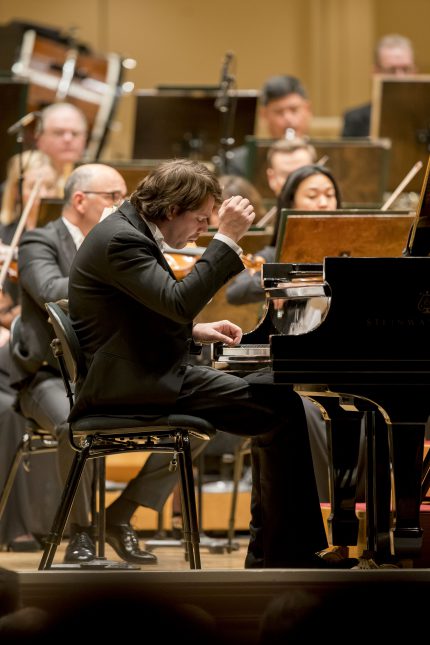Muti, CSO bring respect and brillance to Hindemith symphony
Paul Hindemith still gets no respect.
The music of the prolific German composer-conductor—a regular podium guest with the Chicago Symphony Orchestra— seems to have fallen into something of a repertorial void in the 21st century. Never a crowd pleaser, Hindemith’s brand of Gebrauchsmusik (unhelpfully translated as “utility music”) is neither melodically sumptuous nor drily academic, centering on a kind of knotty contrapuntal rigor that for many seems like gray, relentlessly busy note-spinning.
Yet Hindemith (1895-1963) continues to have his advocates and fans—not least among the latter is Chicago writer, raconteur and urban photographer Jack Zimmerman, who may be the only person on the planet with a Hindemith tattoo.
Riccardo Muti may not have a tattoo, but he has been a consistent podium advocate for Hindemith. On Thursday night, Muti led the first CSO performance in two decades of Hindemith’s symphony Mathis der Maler (Mathis the Painter).
The symphony was written on a commission from Wilhelm Furtwaengler, with Hindemith drawing music from his work-in-progress opera of the same name. The opera is based on the life of the 15th-century painter Matthias Grünewald, who battled both the church and government in his lifetime, eventually deciding to find his life’s solace solely in his art.
The story was a relevant one for Hindemith who had an uneasy relationship with the Nazi authorities. Wilhelm Furtwaengler courageously premiered Mathis der Maler with the Berlin Philharmonic, despite Hindemith being publicly denounced by the Nazi authorities. Seeing the handwriting on the wall, Hindemith and his wife—who was half-Jewish— fled to Switzerland and eventually the U.S. in 1940, both becoming American citizens.
Mathis der Maler is one of Hindemith’s relatively few major works for orchestra. The symphony is scored for large forces, inspired by panels from Grünewald’s celebrated Isenheim altarpiece.
Muti drew a theatrical, big-boned performance that nearly made Mathis der Maler seem like a populist showpiece (in a good way). The somber opening passage of “The Angelic Concert” was given striking weight yet there was no lack of agility in the ensuing Allegro, with Muti clarifying Hindemith’s dense textures. The ensuing “Entombment” section had similar gravitas, with Stefan Ragnar Hoskulddson’s glowing flute benediction bringing solace amid the astringencies.
In the final section, (“The Temptation of Saint Anthony”), Muti and the musicians charted the progress from restless unease and frantic activity into consolatory spiritual relief. There was no mistaking the optimistic trajectory of the symphony’s longest movement, with a resounding brassy triumph in the chorale at the coda.
Muti has been a superb Hindemith advocate in his Chicago tenure and proved so again, bringing out the restless—at times, haunted— contrapuntal drive as well as the quirky brilliance of Hindemith’s scoring. The orchestra delivered superbly across all departments, not least the CSO brass and percussion in the final movement.
Hindemith’s symphony was preceded by four of Brahms’ Hungarian Dances.
Originally written for four-hand piano, the Hungarian Dances were regular concert-hall fare throughout much of the 20th century but seem to have lost favor in recent decades, considered too lightweight for serious symphonic programs. But this is wonderful music, and Muti’s vividly characterized performances of four Hungarian Dances made an offbeat prelude to the less populist Hindemith.
The CSO’s music director drew strikingly dark, rich string tone in the whirling main theme of the Dance No. 1. The Third Dance provided contrast with William Welter’s oboe solo in synch with the music’s quirky rustic charm.
The rarely heard No. 10 was served up with dervish bombast while the most popular of the Dances, No. 5, closed the set in spirited fashion with ample brilliance and panache.
The first half of the program was devoted to familiar Beethoven.
David Fray was the soloist in Beethoven’s Piano Concerto No. 3. The lanky pianist proved a solid protagonist in this middle-period work, fluid in phrasing and polished throughout.
Yet ultimately, this was an admirable Beethoven Third rather than a distinctive one. Fray’s playing felt somewhat inhibited, missing Beethoven’s quirkiness and rustic bonhomie in the finale.
The French pianist was at his best in the Largo, floating the solo line with poised, limpid expression, if not equaling the rapt, mesmerizing quality Mitsuko Uchida brought to this music last year, where time seemed to stand still. Likewise, Fray’s proficient playing failed to match the blend of strength and nuanced detail that his father-in-law on the podium was drawing from the orchestra.
The evening began with a bitingly dramatic performance of the Egmont Overture. Muti, typically, layered dynamics and voicings in such a way that even this warhorse sounded fresh and compelling, enhanced by a fluent oboe solo by William Welter and a blazing account of the triumphant final section.
The program will be repeated 1:30 p.m. Friday. David Fray will perform Mozart’s Piano Concerto No. 24 at the CSO’s Symphony Ball 7 p.m. Saturday. In addition to the Brahms Hungarian Dances, the program will include Josef Strauss’s Sphärenklänge Waltz, Johann Strauss Jr.’s Rosen aus dem Süden Waltz and the Intermezzo from Puccini’s Manon Lescaut. cso.org; 312-294-3000.
Posted in Performances






